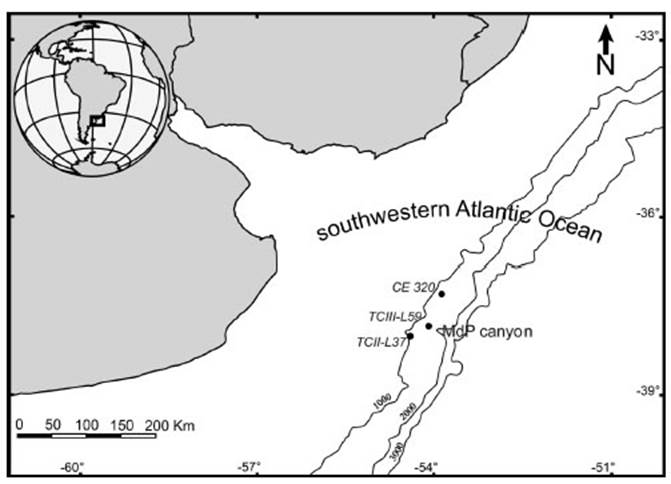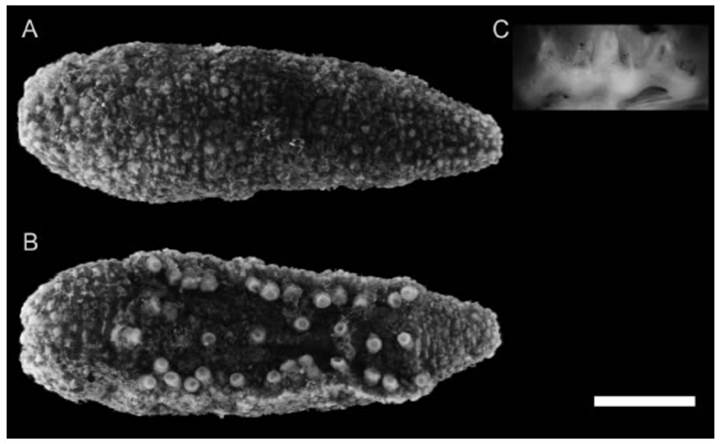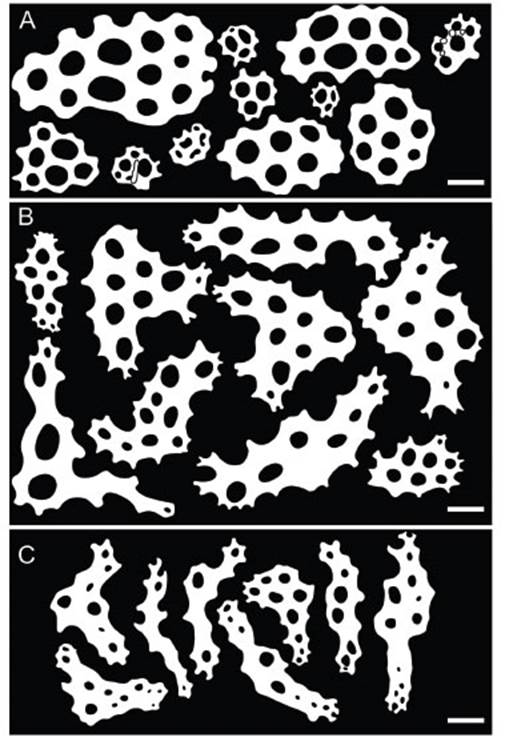INTRODUCTION
The HMS Challenger Expedition changes the way of marine science, and with it the stud ies of marine invertebrates. During that expedi tion, Théel (1882, 1886) described new taxa of Holothuroidea, including the order Elasipodida and seven species of Psolus (Family Psolidae Burmeister, 1837) from South America, includ ing four new species: Psolus incertus; Psolus tuberculosus; Psolus pourtalesi and Psolus mur rayi. The latter was originally described from a single specimen collected at 1000 m depth in the southwest Atlantic (37°17’S, 53°52’W) (Fig. 1).

Fig. 1 Map showing the location of the holotype and the specimens analyzed on this study. MDP Canyon: Mar del Plata submarine canyon.
The genus Psolus belong to the Family Psolidae and has the dorsal body-wall covered with scales (see Martinez 2016). Although this character is very conspicuous and diagnostic, there are other taxa that have dorsal ossicles ar ranged in several layers and high density, which gives them a psolid-like appearance. An example of this is the genus Echinopsolus (Cucumariidae), in which the type species, Echinopsolus acanthoc olaGutt, 1990 has multilayered ossicles in the dorsal body-wall. This could lead to misidentifi cation, as it could be considered as part of Psolus.
Bohn and Hess (2014) moved in several spe cies (from different genera) to Echinopsolus after finding many characteristics in common. These characteristics were integrated into the diagnosis of the genus: all gonochoric; a genital papilla is present on the oral disc, females brood their offspring in five anterior interradial brood pouches; multiple spermatozoa always bundled to bunch-like spermato-zeugmata and spermato zoa with a fusiform head and a hollow cylinder-like mid-piece encircling the anterior end of the flagellum. Those species were Echinopsolus char coti (Vaney, 1906), Echinopsolus koehleri (Vaney, 1914), Echinopsolus mollis (Ludwig & Heding, 1935), Echinopsolus splendidus (Gutt, 1990), Echinopsolus acutus (Massin, 1992). In addition, Massin (1992, 2010), describe two species for the genus, Echinopsolus parvipes Massin, 1992 East Weddel Sea and Echinopsolus excretiospinosus (Massin, 2010). Recently Panina et al. (2020) re described the genus and describe two new species, Echinopsolus sanamyanorum Panina, Stepanov, Smirnov & Martynov, 2020 and E. onekotanensis Panina, Stepanov, Smirnov & Martynov, 2020. From the ten species of Echinopsolus, almost all of them are from Antarctica, except from E. sanamyanorum and E. onekotanensis, which both are from Kamchatka Peninsula area. All these references give us information to identify other Echinopsolus species and spotlight that may be several other species, could be included in this genus. New material have been collected in three cruises in the deep-sea of the southwest ern Altantic, Talud I, II and III, between 2012 and 2013. One of the species collected was Psolus murrayi (Theel 1886). This study is the first re description, since Théel´s work, with new mate rial collected near the type locality site.
MATERIAL AND METHODS
Specimens were collected after the Talud Continental cruises (2012-2013) onboard the B/O Puerto Deseado using dredge trawlers and fish ing nets, in the area of the Mar del Plata subma rine canyon. All the specimens were preserved in ethanol 96%, analysed and dissected under a ste reomicroscope. Digital photos of the specimens were taken using a Canon PowerShot SX110. The ossicles were digitalised using a Zeiss Axio Imager Z1 microscope with an Axiocam HRc dig ital camera and Axiovision software. The speci mens collected, were compared with the type specimen, from the Natural History Museum of UK(NHMUK) and based on the diagnosis made by Theel (1886). New specimens of this species were deposited at the Museo Argentino de Ciencias Naturales Bernardino Rivadavia (MACN).
RESULTS
Phylum Echinodermata Bruguière, Klein, 1734
Class Holothuroidea de Blainville, 1834
Subclass Actinopoda Ludwig, 1891
Order Dendrochirotida Grube, 1840
Family Cucumariidae Ludwig, 1894
Genus Echinopsolus Gutt, 1990
EchinopsolusGutt, 1990: 112. Type species: E. acan thocola Gutt, 1990, by original designation.
MicrochoerusGutt, 1990: 105 [non Wood 1844]. Type species: M. splendidus Gutt, 1990, by original des ignation.
Diagnosis (after Panina et al. 2020): Tentacles 10, ventral pair smaller than others. Mouth and anus terminal. On the dorsal surface of the body present a few tube feet, papillae or warts, scatter about whole body. Ventral surface with a well-developed sole. Dorsal body wall contains one- to multilayered perforated plates. Scales are absent on the dorsal side.
Echinopsolus murrayi (Théel, 1886) comb. nov.
Psolus murrayiThéel, 1886: 85-86.
Diagnosis (modified from Théel, 1886) Body up to 28 mm, not depressed, elongate, cylindrical, with the posterior end tapered, caudiform. The elongated rectangular sole provided with three simple rows of pedicels, those in the middle row fewer and more distant from one another. Mouth and anus dorsal, tentacles ten, ventral pair smaller, males with genital papilla of up to 3 mm. Dorsal body wall thick with papillae full of ossi cles. Body wall with plates and cups. Multilayered plates exclusively on dorsal body wall. Tentacles and podia with curved and straight bars.
Description: Elongate, cylindrical, with the posterior end tapered, caudiform, up to 26 mm, dorsal cover with scales, ventral well define sole. Body and tentacles, white and light brown. Mouth and anus dorsal, dorsal body wall with warts, tentacles 10, with two ventral 1/3 of the size, retracted in all the specimens, number and size observed by dissection. Sole well define with 3 simple rows, marginal podia present, one row (Fig. 2). Calcareous ring simple, one madreporite and one polian vesicle, left side from dorsal view. Retractor muscles wide, around twice the size of the anterior part of a calcareous ring piece. In gonad of specimen MACN-In 44139 (20.19 mm) oocytes of up 776 um (547.77±211.77 n=8). Male specimen MACN-In 44140 (26 mm) a genital pa pillae of 3 mm, present in between two most dor sal tentacles. Respiratory tree up to ⅔ of body to tal length, right slightly longer than left. Ossicles from bodywall, multiperforated plates (110-207 μm) and cups (45-84 μm), and exclusively on dor sal bodywall, multilayered plates. From tentacles and podia, curved and straight perforated bars (100-408 μm) (Fig. 3).
Type locality: Sta 320 HMS Challenger Expedition; Southwestern Atlantic Ocean; 37°17’S, 53°52’W; 1097 m (600 fathoms) (Théel, 1886).
Distribution: southwestern Atlantic (37°17’S, 53°52’O; 54°29’S, 3°43’O), from 1097 to 1398 m depth (Théel, 1886 and herein).
Examined material: Holotype 28 mm, HMS 320, 14-Feb-1876, 37°17’S, 53°52’W, 1097 m, NHMUK 1886.10.2.87; 26 mm, L37 TCII, 25-May-2013, 38°00’S, 54°24’W, 1275 m, MACN-In 44140 (male); 21.81 mm (male), 20.19 mm (fe male), L59 TCIII, 10-Sep-2013, 37°50’S, 54°5’W, 1398 m, MACN-In 44139 (fig 2). (Table 1).
Habitat: Hard substrate.
DISCUSSION
The samples collected enlarge greatly the amount of samples of Echinopsolus murrayi n. comb., until now with only one specimen. The specimens collected have the same diagnostic fea tures of the type species (NHMUK 1886.10.2.87), dorsal warts, ten tentacles and rectangular sole with three rows of podia among other charac ters. In addition, the specimens herein were found near the type locality. The ossicles, also match with the one observed by Théel (1886), which are cups and multiperforated plates. Here we are also describing straight and curved bars from tentacles and podia. This species was also reported by Ludwig & Heding (1935) for Bovet Island (54°29’S, 3°43’W) at 567 m. According to the reference, these specimens have not podia in the middle ambulacra and five valves which are an important difference with the holotype described by Théel (1886) and the specimens studied herein. Because of this and the huge dif ference observed for the locality, these specimens are not E. murrayi. A proper study, focus on these specimens will determine if they are members of Echinopsolus or not.
All the specimens studied lack dorsal scales which indicate that this species does not belong to Psolidae. Théel (1886) observed a dorsal side with multiple warts and cup ossicles, like the one observed herein. The dorsal warts full of ossicles could lead Théel (1886), to misjudge this charac ter with the dorsal scales from Psolus. Although this similarity and other characteristics among Psolus and Echinopsolus are still on-going work (see Bohn & Hess 2014, Panina et al. 2020). In comparison with other Echinopsolus, E. murrayi and E. acanthocola has also dorsal processes with a heavy skeleton and no podia. These characters are quite diagnostic, and enable to separate these two species from their cogeneric. E. acanthocola has the ventro-lateral rows, joint on the poste rior region and a few tube-feet on middle radii, in contrast with E. murrayi which has three clear and separate rows. In addition, E. murrayi has bars and cups, these ossicles are not present on E. acanthocola. Also, this species has multilay ered plates on body wall, tube-feet and tentacles, in contrast with E. murrayi that has multilay ered plates only in dorsal body wall.
The genus Echinopsolus has been associated with Antarctic waters (Bohn & Hess 2014). The specimens found in this work came from the Mar del Plata submarine canyon area and it is the first species of this genus, off Argentina. Several reports have registered Antarctic currents, the Antarctic Intermediate Water (AAIW) and the Upper Circumpolar Deep Water (UCDW). These currents flow from south to north between 1000-2000 m in the area of the Mar del Plata submarine canyon (Preu et al. 2013, Voight et al. 2013). The deep range in which the specimens were found (1097-1398) could indicate how this species appear northern than the co-generic, and north of the Circumpolar Current which has been indicated to be an important barrier for several invertebrates (O´Loughlin et al. 2011). In addi tion, previous reports indicated the association between the Mar del Plata submarine canyon area and Antarctica (Martinez & Penchaszadeh 2017, Martinez et al. 2019). It is still a clue the association among these species and those from Kamchatka Peninsula area. Perhaps future steps could be focus on stablish if it is or not and as sociation.
One male specimen observed has a genital papillae in between the dorsal pair of tentacles. According to Panina et al. (2020), this is not a diagnostic character for Echinopsolus, although several species of the genus have it, and rein force the change of genus made it herein. The female specimens observed, have not broods or any evidence of brood pouches or sacs/pockets, which have been reported for several species of Echinopsolus. The low number of specimens analyzed here, is not enough to dis charge the idea about brooding on this species.












 uBio
uBio 




